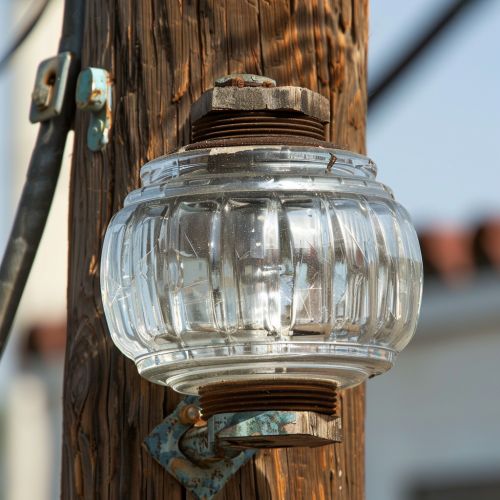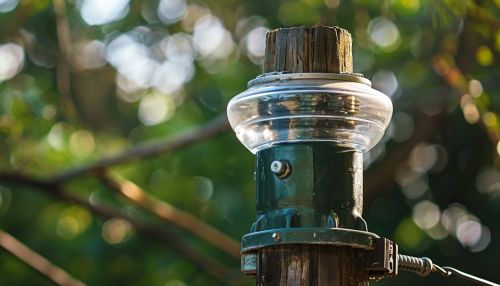Glass insulator
Introduction
A glass insulator is a device used in electrical systems to prevent the unwanted flow of current to the ground from overhead power lines. These insulators are typically made from glass due to its excellent insulating properties, durability, and resistance to environmental factors. Glass insulators have been a critical component in the development and maintenance of electrical infrastructure since the late 19th century.
History
The use of glass insulators dates back to the early days of telegraphy in the mid-1800s. The first glass insulators were designed to support telegraph wires and prevent the loss of electrical signals. Over time, their design evolved to meet the needs of more complex electrical systems, including telephone lines and power distribution networks. By the early 20th century, glass insulators had become a standard component in electrical transmission and distribution systems.
Design and Materials
Glass insulators are typically made from high-quality, annealed glass. The annealing process involves slowly cooling the glass to relieve internal stresses, which enhances its strength and durability. The design of a glass insulator includes several key features:
- Shed: The outermost part of the insulator, designed to shed water and prevent the formation of conductive paths.
- Petticoat: The inner skirts of the insulator that provide additional surface distance for electrical leakage.
- Pinhole: The central hole where the insulator is mounted on a pin, which is then attached to a crossarm or other support structure.


Types of Glass Insulators
There are several types of glass insulators, each designed for specific applications:
Pin-Type Insulators
Pin-type insulators are the most common type used in overhead power lines. They are mounted on a pin, which is attached to a crossarm on a utility pole. These insulators can be single, double, or triple petticoat, depending on the voltage level and environmental conditions.
Suspension Insulators
Suspension insulators are used in high-voltage transmission lines. They consist of a series of glass discs connected in a string, which allows them to support heavy loads and withstand high voltages. Each disc in the string is designed to handle a portion of the total voltage.
Strain Insulators
Strain insulators are used to handle mechanical stress in addition to electrical insulation. They are typically used at dead-end poles, where the line changes direction, or where there is a significant change in elevation.
Manufacturing Process
The manufacturing process of glass insulators involves several steps:
1. Melting: Raw materials, including silica, soda ash, and limestone, are melted in a furnace at high temperatures. 2. Molding: The molten glass is poured into molds to form the insulator's shape. 3. Annealing: The molded insulators are slowly cooled in an annealing oven to relieve internal stresses. 4. Inspection: Each insulator is inspected for defects and tested for electrical and mechanical properties.
Electrical Properties
Glass insulators are designed to provide high electrical resistance and withstand high voltages. Key electrical properties include:
- Dielectric Strength: The maximum electric field that the insulator can withstand without breaking down.
- Leakage Distance: The shortest path along the surface of the insulator between the energized part and the grounded part.
- Creepage Distance: The distance along the surface of the insulator between the energized part and the grounded part, accounting for potential contamination.
Mechanical Properties
In addition to their electrical properties, glass insulators must also possess significant mechanical strength to support the weight of the conductors and withstand environmental forces such as wind and ice. Key mechanical properties include:
- Tensile Strength: The maximum stress that the insulator can withstand while being stretched or pulled.
- Compressive Strength: The maximum stress that the insulator can withstand while being compressed.
- Impact Resistance: The ability of the insulator to withstand sudden impacts without breaking.
Environmental Considerations
Glass insulators are highly resistant to environmental factors such as UV radiation, temperature fluctuations, and chemical exposure. However, they can be susceptible to damage from physical impacts, such as falling branches or vandalism. Regular inspection and maintenance are essential to ensure their continued reliability.
Applications
Glass insulators are used in a variety of applications, including:
- Overhead Power Lines: To support and insulate conductors in transmission and distribution networks.
- Telecommunication Lines: To prevent signal loss and maintain the integrity of communication networks.
- Railway Electrification: To insulate and support overhead catenary systems used in electric railways.
Advantages and Disadvantages
Advantages
- High Dielectric Strength: Glass insulators provide excellent electrical insulation.
- Durability: Resistant to environmental degradation and UV radiation.
- Aesthetic Appeal: Often preferred for their clear or colored glass appearance.
Disadvantages
- Fragility: Susceptible to breakage from physical impacts.
- Weight: Heavier than some alternative materials, such as polymer insulators.
- Cost: Generally more expensive to produce than polymer insulators.
Future Developments
Research and development in the field of insulators continue to explore new materials and designs to improve performance and reduce costs. Advances in composite materials and nanotechnology hold promise for the future of electrical insulation.
